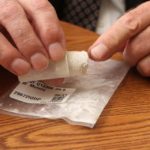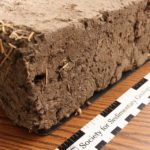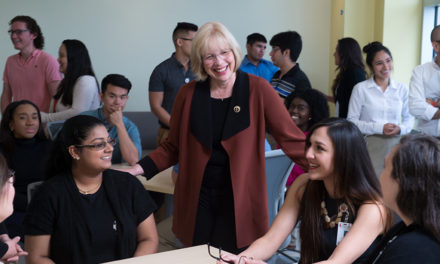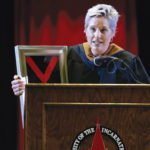
Mulvey in his office at Bonilla Science Hall.
Dr. Gerald Mulvey, assistant professor of meteorology at the University of the Incarnate Word (UIW), is bringing climate change to life in the classroom. An essential element to the meteorology program, Mulvey brings in actual samples of the ocean floor to depict to students what the weather was like ages ago.
“I tell all my students at the very beginning of the program that climate change is in fact occurring and at a much faster rate than it was decades ago,” Mulvey said. “I explain to them they will be charged with figuring out what to do with these changes.”
When charged with such a large task, Mulvey shared that his students become responsive and alert to this challenge. “They realize they are our future and will be responsible for the environment and taking care of the earth, because by then, I will not be here to do it for them,” he said. “They have to do it.”
Mulvey, however, does not just pull out his notes and lectures to teach his students.
“If you teach climatology the old way – the students go to sleep,” he said. “I incorporate in-class demonstrations and/or observations with ocean core samples and whole trees that have been cut in half.”
Mulvey explained he was involved in a series of three workshops offered by the American Meteorological Society that was sponsored by the National Science Foundation that looked at different aspects of climate. The workshops included “Climate Studies Diversity,” “The School of Ice,” and the “Re-Creation of Earth’s Climate History (REACH).”
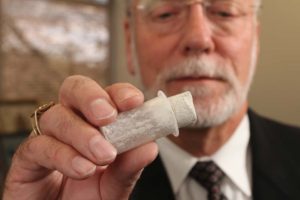
Mulvey displays a core sample from the ocean floor.
“I had the opportunity to pick up some concepts and ideas of how to teach climate and climate change to my students,” he said. “The REACH program was one of the most interesting and was conducted at the Gulf Coast Repository in College Station. This is also where they keep more than 100 kilometers of ocean core.”
Mulvey was able to take samples out of those cores and brought them back to UIW to place on microscope slides to share with his students. “We had talked about ocean core samples and discussed the kinds of calcium animal remains you could see in the samples – these are called diatoms,” he said. “They saw pictures of them in their textbook, so I was actually able to say ‘here are the diatoms we discussed, tell me what you see.’”
Mulvey extended the samples so far as to using Google Earth to zoom in and show his students where the core sample was taken from in the ocean. “I zoom in to the hole that was drilled in the ocean floor and I can tell my students, by the labeling on it, how far down the core sample was taken – all the way down to the centimeter.”
Jill Guse, a junior in the broadcast meteorology degree program at UIW, said Mulvey has made all her courses interesting and she is eager to learn each time she enters the classroom.
“I appreciate all the examples and samples Dr. Mulvey provides for all his courses,” she said. “I think the examples provide me with visual representation of how we, as a whole human population, have affected and will continue to affect everyone on earth.”
Mulvey has also brought pieces of trees into class to teach his students about measuring past climate history. “I have taken out a tree crossection, about one foot across, and laid it on the table in the classroom,” he explained. “Students must have read the material on how to interpret core samples on trees, so I am able to ask, with the tree in front of us, ‘what can you tell me about the climate this tree grew in?’”

Mulvey looks at core samples under microscope.
Mulvey explained the reasoning behind his teaching methods is partially for the students’ exploration and to challenge them, and part of it is allowing them to make their own discoveries.
“By the time our students leave UIW, we want them to not only be able to analyze and evaluate, we want them to be able to create new information,” Mulvey shared. “We try to build them up this ladder of going away from simply memorizing information, to trying to incorporate information and expand on that information.”
Guse shared that she has genuinely enjoyed the meteorology courses she has taken over the years at UIW and they have helped her realize the path she wants to pursue for her career. “The hands-on approach in the class really brings out the material we are learning,” she said. “It not only makes the lessons interesting but makes the information resonate as I move onto other classes.”
“Courses in the UIW Meteorology Program are more than simply teaching about climate study,” Mulvey said. “They are integral with the UIW Mission and educate our students about caring for the earth and about caring for the people on our earth.”
Mulvey said educating students to make informed decisions about climate policies and regulations, and in their personal actions is what will help protect our planet.
“There are seven billion people on earth,” Mulvey explained. “Each one of us as individuals do not impact the climate at all, but as an aggregate of seven-plus billion people? We impact the climate. If each of us, or even 10 percent of us, do some small thing – it has a large impact on the climate and our future.”
Mulvey was featured on KLRN’s “SciTech Now” program discussing his work studying climate change: http://www.klrn.org/blogs/station-news/professor-uses-samples-from-ocean-floor-to-study-climate-change/
By Crystale Galindo
- A tree sample.
- Ocean core samples.
- Ocean core samples.
- Adobe brick sediment.
- Mulvey in his office at Bonilla Science Hall.



